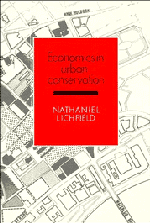Book contents
- Frontmatter
- Contents
- List of diagrams, tables and plans
- Preface
- Acknowledgements
- Introduction
- Part I Planning and management in the conservation of the urban system
- Part II Conservation of the cultural built heritage
- Part III Economics in urban conservation
- Part IV Selected tools of economic analysis for project evaluation
- Part V Case studies in the economics of conservation of the CBH
- Notes
- Bibliography
- Index
Part I - Planning and management in the conservation of the urban system
Published online by Cambridge University Press: 10 November 2010
- Frontmatter
- Contents
- List of diagrams, tables and plans
- Preface
- Acknowledgements
- Introduction
- Part I Planning and management in the conservation of the urban system
- Part II Conservation of the cultural built heritage
- Part III Economics in urban conservation
- Part IV Selected tools of economic analysis for project evaluation
- Part V Case studies in the economics of conservation of the CBH
- Notes
- Bibliography
- Index
Summary
Summary
Urban conservation aims to restrain the rate of change in the urban system (1.7) which embraces the regional systems within which it functions, with a view to achieving a better balance between conservation and development than would otherwise prevail. To assist our understanding of how to do so leads us to formulate a concept of the urban system (1.1) and how this changes through the interaction between people's activities and the physical stock (1.2). In this the urban system is seen as a resource to satisfy human needs, wants and desires (1.3). The resource can be categorised into three interacting components: natural, human and man-made (1.4). It is in relation to each of these that the life cycle is sketched out (1.5) and then discussed in greater depth in respect of the man-made fabric with which we are primarily concerned (1.6). This leads to the general question of why we develop or conserve urban resources (1.7) and to taking into depth the logic of conservation of the three components (1.8).
If a better balance is to be kept between conservation and development there needs to be management of urban resources (Chapter 2). But since management is a function of the proprietary interest in a resource, controlled by the manager on behalf of the owner, we start with a description of the relationship between resource, property and commodity (2.1).
- Type
- Chapter
- Information
- Economics in Urban Conservation , pp. 7 - 10Publisher: Cambridge University PressPrint publication year: 1989



